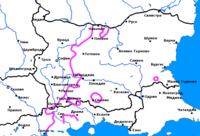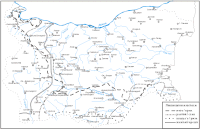Bulgarian dialects
Bulgarian dialectology dates to the 1830s and the pioneering work of Neofit Rilski, Bolgarska gramatika (published 1835 in Kragujevac, Principality of Serbia).
Other notable researchers in this field include Marin Drinov, Konstantin Josef Jireček, Lyubomir Miletich, Aleksandar Teodorov-Balan, Stoyko Stoykov.
So, these political entities are not responsible for the transitional features, but they are basically rooted in other type of evolution, likely in a makeup in the contact area of the two sources of Eastern and Western South Slavic tribes.
All isoglosses commonly share gradual borders deep inside the country, but the northeast always do not, which likely means that the contact zone mixed after the settling of the Slavs in the Balkans.
In eastern Bulgarian dialects in contrast with the other South Slavic languages, standard Ukrainian and Czech, the unstressed vowel e by palatalization turns into i or ie.

1. [mɤʃ] , [zɤp] (see зъб )
2. [maʃ] , [zap] (see заб )
3. [muʃ] , [zup]
4. [mɒʃ] , [zɒp]
5. [mɔʃ] , [zɔp]
6. [mæʃ] , [zæp]
7. [mɤnʃ] , [zɤmp]
8. [manʃ] , [zamp]
9. [mɒnʃ] , [zɒmp]



1. vat- bachva , bochva , etc./ bąchva
2.yellow- zhąlt , zhląt , zhąt, etc./zhelt
3. road- pat, put, pot /pąt
4. paw - shąpa, shapa, shaka, etc./shepa

1. thirsty- zhąden, zhaden , etc./ zheden
2. red- tsraven, tsąrven /cherven, chirven
3. me, you- me, te/mą, tą, etc.
4. white- bel /byal (Yat border)

1. meadows - polani /poleni
2. drunk - piyani /piyeni
3. cups- chashi /cheshi
4. caps- shapki /shepki

1. rings- prąstene, prąsteną/prasteni
2. I read- chetem/chetą
3. we read- cheteme, chitami, chetemo, etc./ chetem , chitem , etc.
4. Yat border

1. leg- noga / krak
2. loom- razboy / stan
3. shirt- koshula / riza
4. hot- zhezhko/goreshto

1. meat- méso/mesó
2. I read- chéta, chetem/chetá
3. pick- béri/berí
4. Yat border



